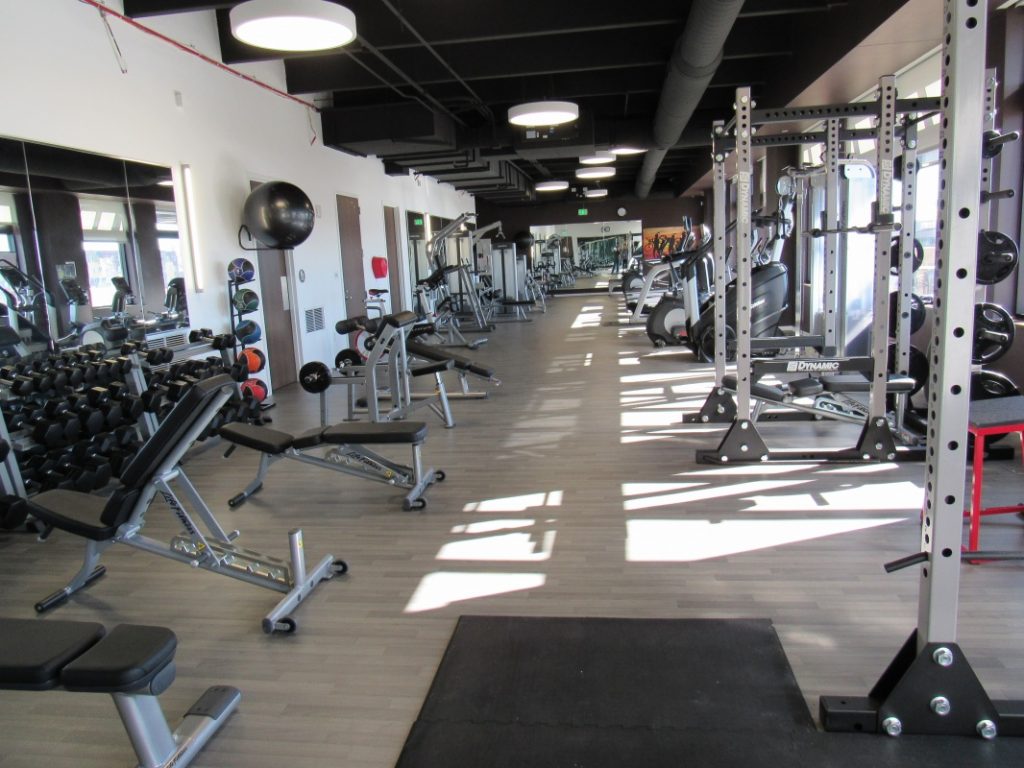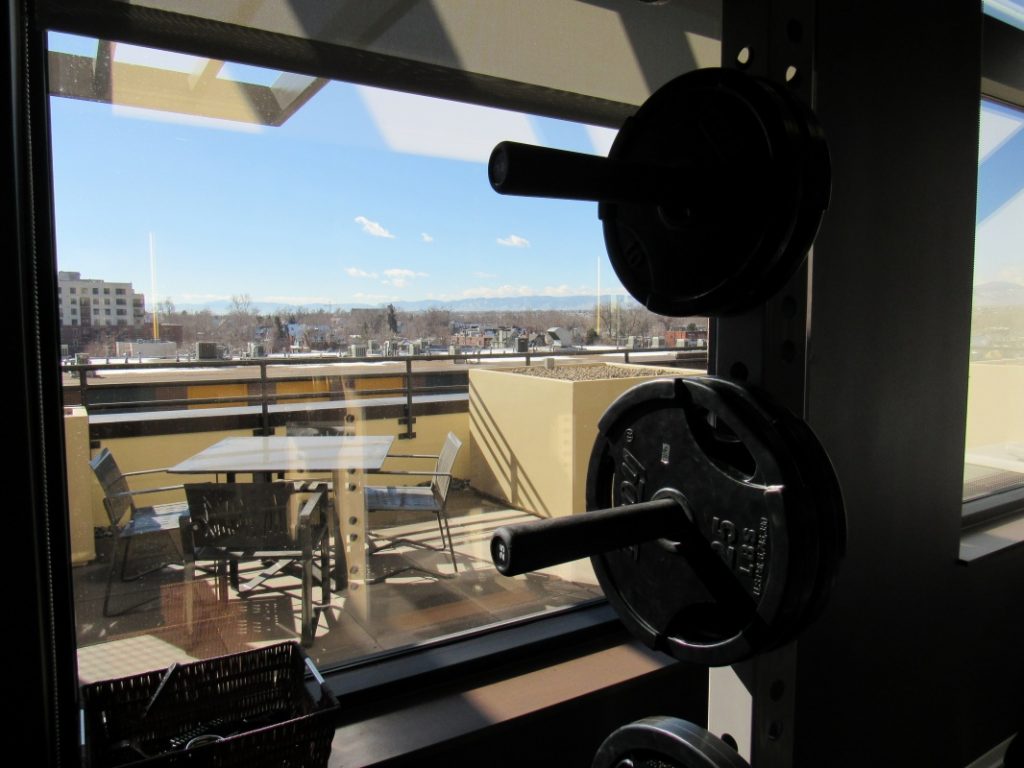Many office buildings and corporate headquarters have embraced well-being and fitness as part of their investment in their employees. When you’re in the business of health, like regional hospital and “health care system” resource Denver Health, your employees have a higher understanding and appreciation of corporate wellness, and expectations for a fitness facility can be high. The employee population works 24-7, demographics are diverse, and needs are expansive. However, budgets are not.
In 2015 as Denver Health was making plans for the new Denver Health Administrative building, which would house close to 1000 employees, Tracy Shea took on the challenge of transforming the existing fitness center into a more useful, practical and productive space for the Denver Health team. “The new Denver Health administration building had space allocated for a yoga/group exercise studio and fitness center,” recalls Shea. “This new space was an upgrade from our old onsite facility, but I needed a new vendor who would not only help design and equip an upgraded fitness center but also help us with preventative maintenance so that the investment has a longer life.”
There were several equipment sales organizations who were more than happy to help, but Tracy had a limited budget and she was looking for a more complete resource, a true partner. She met that partner at the Colorado Culture of Health conference, and they began a two-year journey to create a new fitness and wellness hub for the Denver Health community.
“I began working with Laura on the layout and equipment recommendations that would fit in the space, fit with the needs of our employees, and fit within our budget,” said Shea. “She worked with me onsite at our old facility to walk through options, knowing that we’d be moving in two years. We met with the building design team and worked closely with them until the facility opened in June 2017. Advanced Exercise has been an amazing partner throughout.”
“During that initial discovery meeting, we really like to start with what employees expect from a fitness center,” offers Laura Emrich, one of Advanced Exercise’s fitness design consultants. “If employees have an expectation, what is that expectation? How can we design an ongoing fitness experience that fits within the culture and values of the company? With Denver Health, it’s about accessibility, quality support, and meeting needs at multiple levels. We looked at every detail with those values in mind.”
Denver Health’s old fitness facility had plenty of equipment, to the point where it was overcrowded with a variety of different mismatched pieces, with many accessories and attachments and little-to-no storage. “We were fortunate enough to have close to two years to formulate the best plan for the employees, utilizing the feedback from employee surveys, and working with the architects and designers in creating the most space-efficient and effective fitness center for this community,” added Emrich.
The new fitness facility’s popularity is reflected in the number of employees who are using the new fitness center. The updated center has twice the number of members as the old facility (700 versus 350), and each pays $7.50 per pay period to be a member, slightly more than the $5.00 charged for access to the old facility. The fees fund the fitness center, support resources and all of the programming, allowing for some group exercise class offerings, but the fitness center is not staffed.
Even though the fitness center is unstaffed, it has become a hub of activity. There is a wide variety of equipment options, from cardio training to free weights, circuit training to CrossFit equipment. There’s a group exercise/yoga room that often doubles as a meditation space for employees who just need a break from their shift at the hospital. The fitness center is secured with 24/7 badge access, so members can come whenever it’s convenient for them. There are intermittent group classes, offering about 10 classes each week, but no regular schedule of programming yet.
The locker rooms are shared space with the paramedic units, so the showers and space for changing was an important part of the space planning. It also presented a challenge early on, when the locker room sizes were uneven, but that got sorted out with some inventive rearranging.
As often happens, there were also issues with the building cable and power resources to make sure the cardio equipment can connect and operate properly. “Even with years of planning, there were changes to the TV service and IT infrastructure that were not communicated to us,” said Emrich. “With some creative re-design of the layout and open communication with the AV vendor and project management team, we were able to overcome the challenge and build a successful result.”
Shea has one major regret, as she wishes that “someone with knowledge of fitness center designs would have been included in the initial building design.” She started with Denver Health after the layout designs were set, and the experts at Advanced Exercise came on board even later. Involving a fitness design resource at the beginning of the process would have helped sidestep most of the major build challenges that the team faced, and it could have saved precious budget dollars as well.
Budget considerations were part of every decision, and the team implemented a number of innovative options that have been seamless to end-users. Instead of having personal TV screens on every cardio piece, some pieces are left without screens so that users can have an unimpeded view of the mountains as they work out. Turns out, some people prefer a screen-free workout. Plus, there’s a great patio adjacent to the fitness center where employees congregate to chat, host impromptu employee gatherings or just sit and watch the world go by. Outdoor yoga and other options are sure to follow as warmer weather comes around.
When budget allows, Shea mentioned that she “would like to add some additional functional equipment like TRX options in the center, and have some staffed hours to provide more programs, challenges, and an enhanced customer experience for our members.” Since dollars are tight, Shea has innovated yet again to create a volunteer support structure called the Well-Being Champion Network to help with health challenges and social/team-building activities. The network consists of 55 trained well-being champions from different departments and units across the Denver Health organization. “The well-being champion is a volunteer role aimed at fostering a culture of well-being in a particular work area,” commented Shea. “They help connect employees to available resources as needed, they promote the well-being resources to their teams, and they encourage program participation in all sorts of activities.”
The Well-Being Champion Network is one of the ways that Denver Health puts employee wellness at the center of its mission. Wellness is built into the Denver Health organizational strategy, and they make resources available in four key areas of wellness: physical, financial, emotional and social. “Our program is participatory and not focused on health outcomes,” explains Shea, who proudly offers up the organization’s new branding to prove the point. “This strategy has helped up educate our employees on well-being resources beyond fitness and nutrition.”
The Denver Health corporate well-being committee and well-being champion network communicate frequently and are continually working to evolve the program, including the continual solicitation of employee feedback. Just as with the design of the fitness center, Denver Health employees share opinions and ideas to help Tracy align resources and programs with what employees want. Partnerships with other departments as well as outside organizations has also contributed to the strength of the Denver Health Well-Being initiative. “Leveraging subject matter experts within our organization to support our well-being initiatives has been successful for our program to grow,” says Shea. “Also, partnership with outside organizations like AHA and HealthLinks to leverage available resources and connecting with other area hospitals has helped.”
It’s a lot of puzzle pieces to put together, but Denver Health’s ability to keep employees engaged in multiple well-being initiatives is critical to its own success as an accessible, supportive health network. The fitness center is the physical space where it all comes together, though the impact of all of the programs working in unison extends far beyond its walls.
About Advanced Exercise
Founded in 1986, Advanced Exercise is a leading fitness equipment and facility design resource, representing more than 30 equipment brands to bring clients the best new or used equipment solutions to maximize the use of available space and meet the needs of a diverse community of fitness amenity end users. For more information on fitness equipment and facility design services, visit www.advancedexercise.com or call 800-520-1112 to connect with one of Advanced Exercise’s experts.








